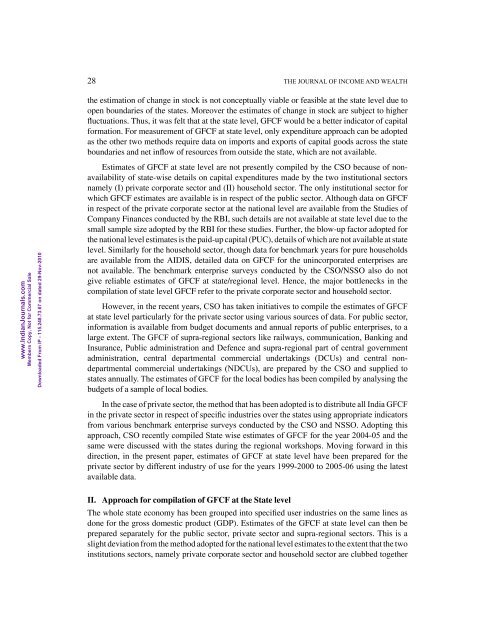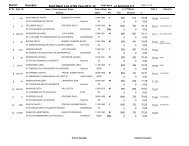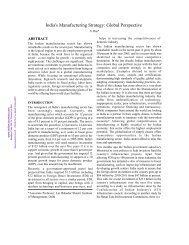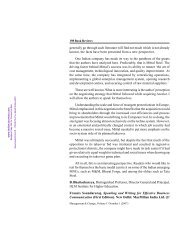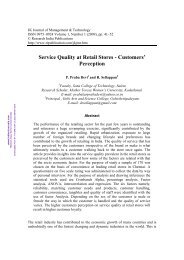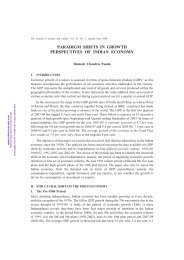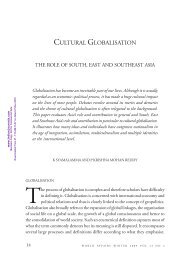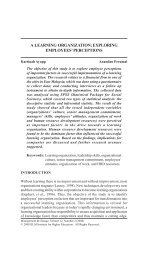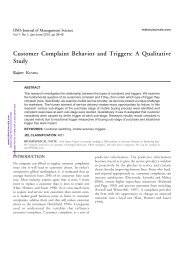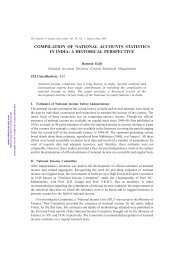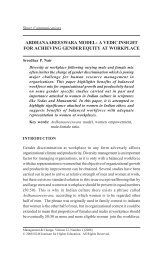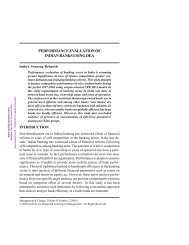16-Estimation of Capital Formation at State Level.pdf - Mimts.org
16-Estimation of Capital Formation at State Level.pdf - Mimts.org
16-Estimation of Capital Formation at State Level.pdf - Mimts.org
Create successful ePaper yourself
Turn your PDF publications into a flip-book with our unique Google optimized e-Paper software.
28 The journal <strong>of</strong> income and wealth<br />
the estim<strong>at</strong>ion <strong>of</strong> change in stock is not conceptually viable or feasible <strong>at</strong> the st<strong>at</strong>e level due to<br />
open boundaries <strong>of</strong> the st<strong>at</strong>es. Moreover the estim<strong>at</strong>es <strong>of</strong> change in stock are subject to higher<br />
fluctu<strong>at</strong>ions. Thus, it was felt th<strong>at</strong> <strong>at</strong> the st<strong>at</strong>e level, GFCF would be a better indic<strong>at</strong>or <strong>of</strong> capital<br />
form<strong>at</strong>ion. For measurement <strong>of</strong> GFCF <strong>at</strong> st<strong>at</strong>e level, only expenditure approach can be adopted<br />
as the other two methods require d<strong>at</strong>a on imports and exports <strong>of</strong> capital goods across the st<strong>at</strong>e<br />
boundaries and net inflow <strong>of</strong> resources from outside the st<strong>at</strong>e, which are not available.<br />
www.IndianJournals.com<br />
Members Copy, Not for Commercial Sale<br />
Downloaded From IP - 115.248.73.67 on d<strong>at</strong>ed 29-Nov-2010<br />
Estim<strong>at</strong>es <strong>of</strong> GFCF <strong>at</strong> st<strong>at</strong>e level are not presently compiled by the CSO because <strong>of</strong> nonavailability<br />
<strong>of</strong> st<strong>at</strong>e-wise details on capital expenditures made by the two institutional sectors<br />
namely (I) priv<strong>at</strong>e corpor<strong>at</strong>e sector and (II) household sector. The only institutional sector for<br />
which GFCF estim<strong>at</strong>es are available is in respect <strong>of</strong> the public sector. Although d<strong>at</strong>a on GFCF<br />
in respect <strong>of</strong> the priv<strong>at</strong>e corpor<strong>at</strong>e sector <strong>at</strong> the n<strong>at</strong>ional level are available from the Studies <strong>of</strong><br />
Company Finances conducted by the RBI, such details are not available <strong>at</strong> st<strong>at</strong>e level due to the<br />
small sample size adopted by the RBI for these studies. Further, the blow-up factor adopted for<br />
the n<strong>at</strong>ional level estim<strong>at</strong>es is the paid-up capital (PUC), details <strong>of</strong> which are not available <strong>at</strong> st<strong>at</strong>e<br />
level. Similarly for the household sector, though d<strong>at</strong>a for benchmark years for pure households<br />
are available from the AIDIS, detailed d<strong>at</strong>a on GFCF for the unincorpor<strong>at</strong>ed enterprises are<br />
not available. The benchmark enterprise surveys conducted by the CSO/NSSO also do not<br />
give reliable estim<strong>at</strong>es <strong>of</strong> GFCF <strong>at</strong> st<strong>at</strong>e/regional level. Hence, the major bottlenecks in the<br />
compil<strong>at</strong>ion <strong>of</strong> st<strong>at</strong>e level GFCF refer to the priv<strong>at</strong>e corpor<strong>at</strong>e sector and household sector.<br />
However, in the recent years, CSO has taken initi<strong>at</strong>ives to compile the estim<strong>at</strong>es <strong>of</strong> GFCF<br />
<strong>at</strong> st<strong>at</strong>e level particularly for the priv<strong>at</strong>e sector using various sources <strong>of</strong> d<strong>at</strong>a. For public sector,<br />
inform<strong>at</strong>ion is available from budget documents and annual reports <strong>of</strong> public enterprises, to a<br />
large extent. The GFCF <strong>of</strong> supra-regional sectors like railways, communic<strong>at</strong>ion, Banking and<br />
Insurance, Public administr<strong>at</strong>ion and Defence and supra-regional part <strong>of</strong> central government<br />
administr<strong>at</strong>ion, central departmental commercial undertakings (DCUs) and central nondepartmental<br />
commercial undertakings (NDCUs), are prepared by the CSO and supplied to<br />
st<strong>at</strong>es annually. The estim<strong>at</strong>es <strong>of</strong> GFCF for the local bodies has been compiled by analysing the<br />
budgets <strong>of</strong> a sample <strong>of</strong> local bodies.<br />
In the case <strong>of</strong> priv<strong>at</strong>e sector, the method th<strong>at</strong> has been adopted is to distribute all India GFCF<br />
in the priv<strong>at</strong>e sector in respect <strong>of</strong> specific industries over the st<strong>at</strong>es using appropri<strong>at</strong>e indic<strong>at</strong>ors<br />
from various benchmark enterprise surveys conducted by the CSO and NSSO. Adopting this<br />
approach, CSO recently compiled St<strong>at</strong>e wise estim<strong>at</strong>es <strong>of</strong> GFCF for the year 2004-05 and the<br />
same were discussed with the st<strong>at</strong>es during the regional workshops. Moving forward in this<br />
direction, in the present paper, estim<strong>at</strong>es <strong>of</strong> GFCF <strong>at</strong> st<strong>at</strong>e level have been prepared for the<br />
priv<strong>at</strong>e sector by different industry <strong>of</strong> use for the years 1999-2000 to 2005-06 using the l<strong>at</strong>est<br />
available d<strong>at</strong>a.<br />
II. Approach for compil<strong>at</strong>ion <strong>of</strong> GFCF <strong>at</strong> the St<strong>at</strong>e level<br />
The whole st<strong>at</strong>e economy has been grouped into specified user industries on the same lines as<br />
done for the gross domestic product (GDP). Estim<strong>at</strong>es <strong>of</strong> the GFCF <strong>at</strong> st<strong>at</strong>e level can then be<br />
prepared separ<strong>at</strong>ely for the public sector, priv<strong>at</strong>e sector and supra-regional sectors. This is a<br />
slight devi<strong>at</strong>ion from the method adopted for the n<strong>at</strong>ional level estim<strong>at</strong>es to the extent th<strong>at</strong> the two<br />
institutions sectors, namely priv<strong>at</strong>e corpor<strong>at</strong>e sector and household sector are clubbed together


